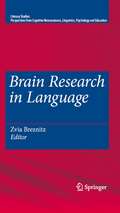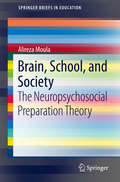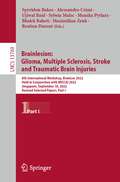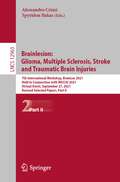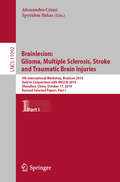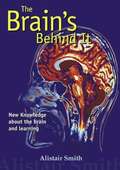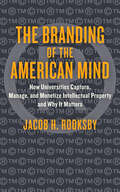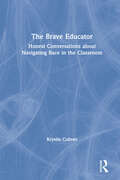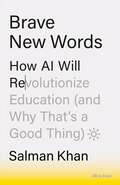- Table View
- List View
Brain Research in Language (Literacy Studies #1)
by Zvia BreznitzBrain Research in Language addresses important neurological issues involved in reading. The reading process is a highly composite cognitive task, which relies on brain systems that were originally devoted to other functions. The majority of studies in this area have used behavioral methodologies. This book presents data obtained from studies employing behavioral, electrophysiological and imaging methodologies focusing on the regular reading process and the dyslexic population.
Brain, School, and Society: The Neuropsychosocial Preparation Theory (SpringerBriefs in Education)
by Alireza MoulaThis book reports on a research program designed to construct the basics of a new type of literacy that teaches pupils social problem-solving at individual and collective levels. It is the first of a series of books about a chain of intervention research subprojects started in 2009 teaching pupils basic skills to make well-balanced decisions; to resolve conflicts in a nonviolent manner; and to develop good social relationships and responsibility, critical thinking, and other abilities which give children and young people the tools needed to pursue their options in life. According to the United Nations, there is no systematic program in schools that develops these capacities in pupils. This volume fills the gap by describing successful classroom interventions and by developing a framework for social problem-solving literacy as mandated by the United Nations Child Convention.
The Brain that Loves to Play: A Visual Guide to Child Development, Play, and Brain Growth
by Jacqueline HardingThis delightful visual book provides an accessible introduction to how play affects the holistic development and brain growth of children from birth to five years. Written by a leading expert, it brings current theory to life by inviting the reader to celebrate the developing brain that loves to play and is hungry for sensitive human interaction and rich play opportunities. Packed full of images and links to film clips of children playing in a variety of contexts on the companion website, chapters focus on different ages and stages of development, providing snapshots of real play scenarios to explore their play preferences and the theory that underpins their play behaviour. With clear explanations of what is happening in the body and brain at each "stage," this book reveals the richness of the play opportunities on offer and the adult’s role in facilitating it. Each chapter follows an easy-to-navigate format which includes: • Best practice boxes showing how play in different contexts has impacted a child’s development • QR codes linking to short film clips on a companion website to exemplify key points • Brain and body facts sections providing short accessible explanations of key theories • Play and pedagogy discussion questions • Extended material to support the level four descriptors for degree-level study. With opportunities to dig deeper, full-colour photographs, and a fully integrated companion website, The Brain that Loves to Play is essential reading for all early years students and practitioners and all those with an interest in child development.
The Brain that Loves to Play: A Visual Guide to Child Development, Play, and Brain Growth
by Jacqueline HardingThis delightful visual book provides an accessible introduction to how play affects the holistic development and brain growth of children from birth to five years. Written by a leading expert, it brings current theory to life by inviting the reader to celebrate the developing brain that loves to play and is hungry for sensitive human interaction and rich play opportunities. Packed full of images and links to film clips of children playing in a variety of contexts on the companion website, chapters focus on different ages and stages of development, providing snapshots of real play scenarios to explore their play preferences and the theory that underpins their play behaviour. With clear explanations of what is happening in the body and brain at each "stage," this book reveals the richness of the play opportunities on offer and the adult’s role in facilitating it. Each chapter follows an easy-to-navigate format which includes: • Best practice boxes showing how play in different contexts has impacted a child’s development • QR codes linking to short film clips on a companion website to exemplify key points • Brain and body facts sections providing short accessible explanations of key theories • Play and pedagogy discussion questions • Extended material to support the level four descriptors for degree-level study. With opportunities to dig deeper, full-colour photographs, and a fully integrated companion website, The Brain that Loves to Play is essential reading for all early years students and practitioners and all those with an interest in child development.
Brain Train: Studying for success
by Dr Richard Palmer Richard PalmerA new edition of a highly successful study skills books. The style and approach is particularly suited to current student needs as the author stresses the importance of adopting a positive response to study. The lively and enthusiastic tone, and the practical advice on everything from planning revision to designing CVs gives this book enormous appeal to all, from A-level to mature students.
Brain Train: Studying for success
by Dr Richard Palmer Richard PalmerA new edition of a highly successful study skills books. The style and approach is particularly suited to current student needs as the author stresses the importance of adopting a positive response to study. The lively and enthusiastic tone, and the practical advice on everything from planning revision to designing CVs gives this book enormous appeal to all, from A-level to mature students.
Brain Words: How the Science of Reading Informs Teaching
by J. Richard Gentry Gene OuelletteThe past two decades have brought giant leaps in our understanding of how the brain works. But these discoveries-;and all their exciting implications-;have yet to make their way into most classrooms.In Brain Words: How the Science of Reading Informs Teaching , authors J. Richard Gentry and Gene Ouellette, bring their original, research-based framework of brain words dictionaries in the brain where students store and automatically access sounds, spellings, and meaning. This book aims to fill the gap between the science of reading and classroom instruction by providing up-to-date knowledge about reading and neurological circuitry, including evidence that spelling is at the core of the reading brain.Brain Words will show how children's brains develop as they become readers and discover ways you can take concrete steps to promote this critical developmental passage, including: Incorporating tools to recognize what works, what doesn't, and whyPractical classroom activities for daily teaching and student assessmentInsights about what brain research tells us about whole language and phonics-first movementsDeepened understanding of dyslexia through the enhanced lens of brain scienceWith the insights and strategies of Brain Words , you can meet your students where they are and ensure they gain confidence as readers, spellers, and writers.
Brain Words: How the Science of Reading Informs Teaching
by J. Richard Gentry Gene OuelletteThe past two decades have brought giant leaps in our understanding of how the brain works. But these discoveries-;and all their exciting implications-;have yet to make their way into most classrooms.In Brain Words: How the Science of Reading Informs Teaching , authors J. Richard Gentry and Gene Ouellette, bring their original, research-based framework of brain words dictionaries in the brain where students store and automatically access sounds, spellings, and meaning. This book aims to fill the gap between the science of reading and classroom instruction by providing up-to-date knowledge about reading and neurological circuitry, including evidence that spelling is at the core of the reading brain.Brain Words will show how children's brains develop as they become readers and discover ways you can take concrete steps to promote this critical developmental passage, including: Incorporating tools to recognize what works, what doesn't, and whyPractical classroom activities for daily teaching and student assessmentInsights about what brain research tells us about whole language and phonics-first movementsDeepened understanding of dyslexia through the enhanced lens of brain scienceWith the insights and strategies of Brain Words , you can meet your students where they are and ensure they gain confidence as readers, spellers, and writers.
The 'BrainCanDo' Handbook of Teaching and Learning: Practical Strategies to Bring Psychology and Neuroscience into the Classroom
by Julia HarringtonThe 'BrainCanDo' Handbook of Teaching and Learning provides teachers and school leaders with a concise summary of how some of the latest research in educational neuroscience and psychology can improve learning outcomes. It aims to create a mechanism through which our growing understanding of the brain can be applied in the world of education. Subjects covered include memory, social development, mindsets and character. Written by practising teachers working in collaboration with researchers, the chapters provide a toolkit of practical ideas which incorporate evidence from psychology and neuroscience into teaching practice with the aim of improving educational outcomes for all. By increasing both teachers’ and pupils’ understanding of the developing brain, ‘BrainCanDo’ aims to improve cognitive performance and attainment, foster a love of learning and enable a healthy and productive approach to personal development. This book will appeal to educators, primarily those working in secondary schools, but also those within higher and primary school education. It will also be of interest to students of education, professionals looking to enhance their teaching and researchers working in the fields of education, psychology and neuroscience.
The 'BrainCanDo' Handbook of Teaching and Learning: Practical Strategies to Bring Psychology and Neuroscience into the Classroom
by Julia Harrington Jonathan Beale Amy Fancourt Catherine LutzThe 'BrainCanDo' Handbook of Teaching and Learning provides teachers and school leaders with a concise summary of how some of the latest research in educational neuroscience and psychology can improve learning outcomes. It aims to create a mechanism through which our growing understanding of the brain can be applied in the world of education. Subjects covered include memory, social development, mindsets and character. Written by practising teachers working in collaboration with researchers, the chapters provide a toolkit of practical ideas which incorporate evidence from psychology and neuroscience into teaching practice with the aim of improving educational outcomes for all. By increasing both teachers’ and pupils’ understanding of the developing brain, ‘BrainCanDo’ aims to improve cognitive performance and attainment, foster a love of learning and enable a healthy and productive approach to personal development. This book will appeal to educators, primarily those working in secondary schools, but also those within higher and primary school education. It will also be of interest to students of education, professionals looking to enhance their teaching and researchers working in the fields of education, psychology and neuroscience.
Brainlesion: 8th International Workshop, BrainLes 2022, Held in Conjunction with MICCAI 2022, Singapore, September 18, 2022, Revised Selected Papers, Part I (Lecture Notes in Computer Science #13769)
by Spyridon Bakas Alessandro Crimi Ujjwal Baid Sylwia Malec Monika Pytlarz Bhakti Baheti Maximilian Zenk Reuben DorentThis book constitutes the refereed proceedings of the 8th International MICCAI Brainlesion Workshop, BrainLes 2022, as well as the Brain Tumor Segmentation (BraTS) Challenge, the Brain Tumor Sequence Registration (BraTS-Reg) Challenge, the Cross-Modality Domain Adaptation (CrossMoDA) Challenge, and the Federated Tumor Segmentation (FeTS) Challenge. These were held jointly at the Medical Image Computing for Computer Assisted Intervention Conference, MICCAI 2022, in September 2022. The 46 revised full papers presented in these volumes were selected form 65 submissions.The presented contributions describe the research of computational scientists and clinical researchers working on brain lesions - specifically glioma, multiple sclerosis, cerebral stroke, traumatic brain injuries, vestibular schwannoma, and white matter hyper-intensities of presumed vascular origin.
Brainlesion: 8th International Workshop, BrainLes 2022, Held in Conjunction with MICCAI 2022, Singapore, September 18, 2022, Revised Selected Papers, Part II (Lecture Notes in Computer Science #14092)
by Spyridon Bakas Alessandro Crimi Ujjwal Baid Sylwia Malec Monika Pytlarz Bhakti Baheti Maximilian Zenk Reuben DorentThis two volume-set LNCS 13769 and LNCS 14092 constitutes the refereed proceedings of the 8th International MICCAI Brainlesion Workshop, BrainLes 2022, as well as the Brain Tumor Segmentation (BraTS) Challenge, the Brain Tumor Sequence Registration (BraTS-Reg) Challenge, the Cross-Modality Domain Adaptation (CrossMoDA) Challenge, and the Federated Tumor Segmentation (FeTS) Challenge. These were held jointly at the Medical Image Computing for Computer Assisted Intervention Conference, MICCAI 2022, in September 2022. The 46 revised full papers presented in these volumes were selected form 65 submissions.The presented contributions describe the research of computational scientists and clinical researchers working on brain lesions - specifically glioma, multiple sclerosis, cerebral stroke, traumatic brain injuries, vestibular schwannoma, and white matter hyper-intensities of presumed vascular origin.
Brainlesion: 7th International Workshop, BrainLes 2021, Held in Conjunction with MICCAI 2021, Virtual Event, September 27, 2021, Revised Selected Papers, Part II (Lecture Notes in Computer Science #12963)
by Alessandro Crimi Spyridon BakasThis two-volume set LNCS 12962 and 12963 constitutes the thoroughly refereed proceedings of the 7th International MICCAI Brainlesion Workshop, BrainLes 2021, as well as the RSNA-ASNR-MICCAI Brain Tumor Segmentation (BraTS) Challenge, the Federated Tumor Segmentation (FeTS) Challenge, the Cross-Modality Domain Adaptation (CrossMoDA) Challenge, and the challenge on Quantification of Uncertainties in Biomedical Image Quantification (QUBIQ). These were held jointly at the 23rd Medical Image Computing for Computer Assisted Intervention Conference, MICCAI 2020, in September 2021. The 91 revised papers presented in these volumes were selected form 151 submissions. Due to COVID-19 pandemic the conference was held virtually.
Brainlesion: 5th International Workshop, BrainLes 2019, Held in Conjunction with MICCAI 2019, Shenzhen, China, October 17, 2019, Revised Selected Papers, Part I (Lecture Notes in Computer Science #11992)
by Alessandro Crimi Spyridon BakasThe two-volume set LNCS 11992 and 11993 constitutes the thoroughly refereed proceedings of the 5th International MICCAI Brainlesion Workshop, BrainLes 2019, the International Multimodal Brain Tumor Segmentation (BraTS) challenge, the Computational Precision Medicine: Radiology-Pathology Challenge on Brain Tumor Classification (CPM-RadPath) challenge, as well as the tutorial session on Tools Allowing Clinical Translation of Image Computing Algorithms (TACTICAL). These were held jointly at the Medical Image Computing for Computer Assisted Intervention Conference, MICCAI, in Shenzhen, China, in October 2019. The revised selected papers presented in these volumes were organized in the following topical sections: brain lesion image analysis (12 selected papers from 32 submissions); brain tumor image segmentation (57 selected papers from 102 submissions); combined MRI and pathology brain tumor classification (4 selected papers from 5 submissions); tools allowing clinical translation of image computing algorithms (2 selected papers from 3 submissions.)
The Brain's Behind It
by Alistair SmithAT LAST! Alistair Smith's latest book is the product of three years research. If you want to know more about the brain and learning, this is the book you need. With separate sections on the development cycle of the learning brain from conception to old age, the book sets out to separate fact from fallacy, findings from fads. Clear guidance is given as to what helps and what hinders learning. Highly readable, illustrated throughout and well researched, the book will appeal to parents, educators and policy-makers. The Brain's Behind It promises to become the definitive book on the brain and learning.
Brains Inventing Themselves: Choice And Engaged Learning (Transgressions #78)
by Conrad P. PritscherNeuroscience has found that neuroplasticity of brain cells allows brains to invent themselves. Remodeling of brains can be facilitated by schools and universities. What may be done to accelerate that positive inventing so as to prepare for rapidly accelerating change? As an IBM advertisement reads: “It is time to ask smarter questions.” This book helps the reader do that. What is worse than being blind to something? “Being blind to your blindness” says Eric Haseltine who has worked for both Disney and the National Security Agency. Being blind to what our brains can do is slowly changing. Brain researchers recently found that we can now be our own subjects of brain experimentation. Research shows how one can change one’s brain by changing one’s mind. In her 2010 high school valedictorian speech Erica Goldson courageously said: “The majority of students are put through the same brainwashing techniques in order to create a complacent labor force working in the interests of large corporations and secretive government, and worst of all, they are completely unaware of it.” This book shows professors, teachers, parents, and interested citizens how students can become aware and reach higher levels of consciousness.
BrandED: Tell Your Story, Build Relationships, and Empower Learning
by Eric Sheninger Trish RubinPraise for BrandED "A great resource for educators who want to strengthen their connections with students, teachers, parents, and the wider community. These two innovative leaders don't just capture how to tell the story of a school—they show how to create it."—Adam Grant, New York Times bestselling author of Originals and Give and Take "Every day in every one of your schools, great things happen. How does your community know? Schools that are Future Ready boldly engage their community to build relationships and empower both students and families. Powerful yet practical, BrandED is the perfect resource to help your school share its story with the world."—Thomas C. Murray, Director of Innovation, Future Ready Schools "Eric and Trish demystify what it means to brand one's school by providing eight compelling conversations that not only lead to a deeper understanding of branding, but provide relevant ways for school leaders to frame their work… . In the vast sea of information in which we currently reside, using the BrandED Leadership methods described in this book will help school leaders reach their audiences in ways that create trusting relationships and loyalty."—Dwight Carter, Principal, New Albany High School "Disruption is the new normal. And the great disruptors of our time are shaping the culture itself in innovative ways. Eric and Trish's book BrandED sends a very compelling message to school leaders that developing and executing a smart, innovative brand strategy can disrupt the best practices' conventions of the existing school system. Like great disruptive brands from Apple to Uber, educators now have the ability to get the community engaged and immersed in the school's brand equity—and BrandED provides the roadmap for getting there."—Scott Kerr, Executive Director of Strategy and Insights, Time Inc. A brand is built around three key elements: image, promise, and result. The power of a brand to communicate all three elements is undeniable, and in today's digitally connected, social society, schools and school districts have a lot to gain by developing and promoting their own brand identities. BrandED is the groundbreaking guidebook for educators who want to enhance communication with students, parents, and stakeholders to create a transparent record of value. You know great achievements happen at your school. Unfortunately, many of those stories stop at the school doors. This hands-on guide from two rising stars in the education field, Eric Sheninger and Trish Rubin, empowers educators at all levels to take control of how the mission, values, and vision of their schools is communicated. An engaging collection of transformative conversations lead you to discover the opportunities and benefits of designing a brand for your school and sustaining a BrandED community to evangelize it. Even if you have no marketing experience, the easy-to-use framework takes you step by step through the nuances of spreading good news about your school and building relationships around those actions. Timesaving, practical advice prepares you to begin innovating at your school right away, and convenient tips and reflections at the end of each chapter make it easy to integrate the BrandED mindset and practices into your everyday routine. Become a driving force behind your school getting the recognition it deserves by: Branding yourself as your school's storyteller-in-chief and amplifier through a variety of traditional and digital tools and platforms Improving relationships with key stakeholders, developing strategic partnerships, and attracting more resources and opportunities Fostering a positive culture extending and influencing beyond the school grounds BrandE
BrandED: Tell Your Story, Build Relationships, and Empower Learning
by Eric Sheninger Trish RubinPraise for BrandED "A great resource for educators who want to strengthen their connections with students, teachers, parents, and the wider community. These two innovative leaders don't just capture how to tell the story of a school—they show how to create it."—Adam Grant, New York Times bestselling author of Originals and Give and Take "Every day in every one of your schools, great things happen. How does your community know? Schools that are Future Ready boldly engage their community to build relationships and empower both students and families. Powerful yet practical, BrandED is the perfect resource to help your school share its story with the world."—Thomas C. Murray, Director of Innovation, Future Ready Schools "Eric and Trish demystify what it means to brand one's school by providing eight compelling conversations that not only lead to a deeper understanding of branding, but provide relevant ways for school leaders to frame their work… . In the vast sea of information in which we currently reside, using the BrandED Leadership methods described in this book will help school leaders reach their audiences in ways that create trusting relationships and loyalty."—Dwight Carter, Principal, New Albany High School "Disruption is the new normal. And the great disruptors of our time are shaping the culture itself in innovative ways. Eric and Trish's book BrandED sends a very compelling message to school leaders that developing and executing a smart, innovative brand strategy can disrupt the best practices' conventions of the existing school system. Like great disruptive brands from Apple to Uber, educators now have the ability to get the community engaged and immersed in the school's brand equity—and BrandED provides the roadmap for getting there."—Scott Kerr, Executive Director of Strategy and Insights, Time Inc. A brand is built around three key elements: image, promise, and result. The power of a brand to communicate all three elements is undeniable, and in today's digitally connected, social society, schools and school districts have a lot to gain by developing and promoting their own brand identities. BrandED is the groundbreaking guidebook for educators who want to enhance communication with students, parents, and stakeholders to create a transparent record of value. You know great achievements happen at your school. Unfortunately, many of those stories stop at the school doors. This hands-on guide from two rising stars in the education field, Eric Sheninger and Trish Rubin, empowers educators at all levels to take control of how the mission, values, and vision of their schools is communicated. An engaging collection of transformative conversations lead you to discover the opportunities and benefits of designing a brand for your school and sustaining a BrandED community to evangelize it. Even if you have no marketing experience, the easy-to-use framework takes you step by step through the nuances of spreading good news about your school and building relationships around those actions. Timesaving, practical advice prepares you to begin innovating at your school right away, and convenient tips and reflections at the end of each chapter make it easy to integrate the BrandED mindset and practices into your everyday routine. Become a driving force behind your school getting the recognition it deserves by: Branding yourself as your school's storyteller-in-chief and amplifier through a variety of traditional and digital tools and platforms Improving relationships with key stakeholders, developing strategic partnerships, and attracting more resources and opportunities Fostering a positive culture extending and influencing beyond the school grounds BrandE
The Branding of the American Mind: How Universities Capture, Manage, and Monetize Intellectual Property and Why It Matters (Critical University Studies)
by Jacob H. RooksbyUniversities generate an enormous amount of intellectual property, including copyrights, trademarks, patents, Internet domain names, and even trade secrets. Until recently, universities often ceded ownership of this property to the faculty member or student who created or discovered it in the course of their research. Increasingly, though, universities have become protective of this property, claiming it for their own use and licensing it as a revenue source instead of allowing it to remain in the public sphere. Many universities now behave like private corporations, suing to protect trademarked sports logos, patents, and name brands.Yet how can private rights accumulation and enforcement further the public interest in higher education? What is to be gained and lost as institutions become more guarded and contentious in their orientation toward intellectual property? In this pioneering book, law professor Jacob H. Rooksby uses a mixture of qualitative, quantitative, and legal research methods to grapple with those central questions, exposing and critiquing the industry;€™s unquestioned and growing embrace of intellectual property from the perspective of research in law, higher education, and the social sciences.While knowledge creation and dissemination have a long history in higher education, using intellectual property as a vehicle for rights staking and enforcement is a relatively new and, as Rooksby argues, dangerous phenomenon for the sector. The Branding of the American Mind points to higher education;€™s love affair with intellectual property itself, in all its dimensions, including newer forms that are less tied to scholarly output. The result is an unwelcome assault on the public;€™s interest in higher education. Presuming no background knowledge of intellectual property, and ending with a call to action, The Branding of the American Mind explores applicable laws, legal regimes, and precedent in plain English, making the book appealing to anyone concerned for the future of higher education.
The Branding of the American Mind: How Universities Capture, Manage, and Monetize Intellectual Property and Why It Matters (Critical University Studies)
by Jacob H. RooksbyUniversities generate an enormous amount of intellectual property, including copyrights, trademarks, patents, Internet domain names, and even trade secrets. Until recently, universities often ceded ownership of this property to the faculty member or student who created or discovered it in the course of their research. Increasingly, though, universities have become protective of this property, claiming it for their own use and licensing it as a revenue source instead of allowing it to remain in the public sphere. Many universities now behave like private corporations, suing to protect trademarked sports logos, patents, and name brands.Yet how can private rights accumulation and enforcement further the public interest in higher education? What is to be gained and lost as institutions become more guarded and contentious in their orientation toward intellectual property? In this pioneering book, law professor Jacob H. Rooksby uses a mixture of qualitative, quantitative, and legal research methods to grapple with those central questions, exposing and critiquing the industry;€™s unquestioned and growing embrace of intellectual property from the perspective of research in law, higher education, and the social sciences.While knowledge creation and dissemination have a long history in higher education, using intellectual property as a vehicle for rights staking and enforcement is a relatively new and, as Rooksby argues, dangerous phenomenon for the sector. The Branding of the American Mind points to higher education;€™s love affair with intellectual property itself, in all its dimensions, including newer forms that are less tied to scholarly output. The result is an unwelcome assault on the public;€™s interest in higher education. Presuming no background knowledge of intellectual property, and ending with a call to action, The Branding of the American Mind explores applicable laws, legal regimes, and precedent in plain English, making the book appealing to anyone concerned for the future of higher education.
The Brave Educator: Honest Conversations about Navigating Race in the Classroom
by Krystle CobranThe Brave Educator equips you with accessible and refreshingly useful tools for real conversations about race that prepare students for the world beyond the school walls. More than a toolkit, this book is a personal conversation exploring the journey from being stuck in the belief that we should already know how to lead conversations about race to learning how to actually have the conversation. It’s companionship for educators, leaders, and teachers facing overwhelming daily responsibilities and searching for open-hearted support. Inside you’ll find a flexible road map to help carve a path through difficult conversations in your classroom, plus question prompts, resource lists, and crucial tips to help you avoid common pitfalls. The grounded perspective and real-world examples in these pages will help you feel less alone as you move from tentative to prepared.
The Brave Educator: Honest Conversations about Navigating Race in the Classroom
by Krystle CobranThe Brave Educator equips you with accessible and refreshingly useful tools for real conversations about race that prepare students for the world beyond the school walls. More than a toolkit, this book is a personal conversation exploring the journey from being stuck in the belief that we should already know how to lead conversations about race to learning how to actually have the conversation. It’s companionship for educators, leaders, and teachers facing overwhelming daily responsibilities and searching for open-hearted support. Inside you’ll find a flexible road map to help carve a path through difficult conversations in your classroom, plus question prompts, resource lists, and crucial tips to help you avoid common pitfalls. The grounded perspective and real-world examples in these pages will help you feel less alone as you move from tentative to prepared.
Brave Heads: How To Lead A School Without Selling Your Soul
by Dave HarrisSchool leadership brings with it tremendous pressure from the government for results at all costs. It's the outcome that counts (and the league tables) not the process. Which means, now more than ever, for genuine leaders leading schools in the right direction for the right reasons, bravery is key. Dave Harris is well placed to write the ultimate guide to bravery in school leadership. As the principal of a high-profile brand-new Academy he has had to stand by his beliefs about the role of school and the community - 'It's a marathon, not a sprint' - despite the pressure to forget genuinely educating young people and just focus on 'floor targets'. A book for every head teacher who wants to make a genuine difference (and get great results as Dave has done)!
Brave Heads: How to lead a school without selling your soul
by Dave HarrisSchool leadership brings with it tremendous pressure from the government for results at all costs. It's the outcome that counts (and the league tables) not the process. Which means, now more than ever, for genuine leaders leading schools in the right direction for the right reasons, bravery is key. Dave Harris is well placed to write the ultimate guide to bravery in school leadership. As the principal of a high-profile brand-new Academy he has had to stand by his beliefs about the role of school and the community - 'It's a marathon, not a sprint' - despite the pressure to forget genuinely educating young people and just focus on 'floor targets'. A book for every head teacher who wants to make a genuine difference (and get great results as Dave has done)!
Brave New Words: How AI Will Revolutionize Education (and Why That’s a Good Thing)
by Salman Khan‘Salman Khan has long been on the cutting edge of education, and in Brave New Words, he shows us what’s next. The book is a timely master class for anyone interested in the future of learning in the AI era. No one has thought more about these issues—or has more interesting things to say about them’ Bill GatesWhether we like it or not, the AI revolution is coming to education. In Brave New Words, Salman Khan, the visionary behind Khan Academy, explores how artificial intelligence and GPT technology will transform learning, offering a roadmap for teachers, parents, and students to navigate this exciting (and sometimes intimidating) new world.A pioneer in the world of education technology, Khan explains the ins and outs of these cutting-edge tools and how they will forever change the way we learn and teach. Rather than approaching the ChatGPT revolution with white-knuckled fear, Khan wants parents and teachers to embrace AI and adapt to it (while acknowledging its imperfections and limitations). He emphasizes that embracing AI in education is not about replacing human interaction but enhancing it, so that every student can complement the work they're already doing in profoundly new and creative ways, to personalize learning, adapt assessments, and support success in the classroom, preparing students for an increasingly digital future.But Brave New Words is not just about technology - it's about what this technology means for our society, and the practical implications for administrators, guidance counsellors, and hiring managers who can harness the power of AI in education and the workplace. Khan also delves into the ethical and social implications of AI and GPT, offering thoughtful insights into how we can use these tools to build a more accessible education system for students around the world.
